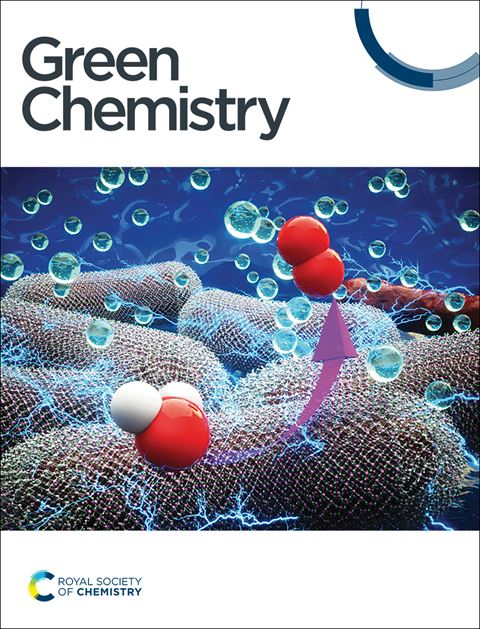Novel sustainable synthesis of a formaldehyde-free thermosetting phenolic resin through solvent-free reactive extrusion†
IF 9.3
1区 化学
Q1 CHEMISTRY, MULTIDISCIPLINARY
引用次数: 0
Abstract
This study proposes a new and elegant way to synthesize thermosetting phenolic resins through a green, solvent-free and versatile reactive extrusion route. In that frame, terephthalaldehyde (TPA), a non-toxic aromatic dialdehyde, has been selected to replace formaldehyde while resorcinol has been chosen as a replacement of phenol. The syntheses were performed without solvent at temperatures between 150 and 170 °C with a reaction time of around 3 minutes. The resins were synthesized at different TPA-to-resorcinol molar ratios (0.6 and 1.6). This study investigates the mechanism and chemical reactions occurring during the reactive extrusion by characterizing the resin composition through NMR and mass spectrometry (<1500 g mol−1). In addition, differential scanning calorimetry (DSC) analyses were carried out to study the kinetics of the reactions and to estimate the activation energies (32–54 kJ mol−1) through various calculation methods (Flynn–Wall–Ozawa, Friedman, and Vyazovkin methods). It was demonstrated that multiple and consecutive reactions (electrophilic aromatic substitution and condensation) occur during the reactive extrusion process. Additionally, the resins synthesized by reactive extrusion exhibited an exothermic post-reactivity signature in DSC, enabling the estimation of the conversion degrees of 0.63 and 0.59, respectively, for ratios of 0.6 and 1.6. Finally, the resins obtained through reactive extrusion demonstrate great thermal stability even prior to post-heating.

求助全文
约1分钟内获得全文
求助全文
来源期刊

Green Chemistry
化学-化学综合
CiteScore
16.10
自引率
7.10%
发文量
677
审稿时长
1.4 months
期刊介绍:
Green Chemistry is a journal that provides a unique forum for the publication of innovative research on the development of alternative green and sustainable technologies. The scope of Green Chemistry is based on the definition proposed by Anastas and Warner (Green Chemistry: Theory and Practice, P T Anastas and J C Warner, Oxford University Press, Oxford, 1998), which defines green chemistry as the utilisation of a set of principles that reduces or eliminates the use or generation of hazardous substances in the design, manufacture and application of chemical products. Green Chemistry aims to reduce the environmental impact of the chemical enterprise by developing a technology base that is inherently non-toxic to living things and the environment. The journal welcomes submissions on all aspects of research relating to this endeavor and publishes original and significant cutting-edge research that is likely to be of wide general appeal. For a work to be published, it must present a significant advance in green chemistry, including a comparison with existing methods and a demonstration of advantages over those methods.
 求助内容:
求助内容: 应助结果提醒方式:
应助结果提醒方式:


